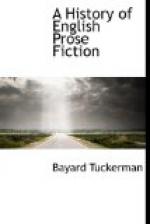The tales of the yeomanry were very popular during the sixteenth century, and were sold as penny chapbooks for many years. They form an interesting link in the history of English prose fiction, representing as they do the first appearance of a popular demand for prose stories, and the first appearance, except in Chaucer, of other than military or clerical heroes. They possess an element of reality which separates the chivalric ideal of the Middle Ages from the pastoral-chivalric ideal of Elizabeth’s time, the latter typified by Sidney’s “Arcadia.” The tales relating to the conjurers are quite mediaeval in character. They are of interest only so far as they serve to illustrate the effect of popular superstition upon the literature of the time.
The New Learning, growing up in the place of war and theology, meant the dawn of material prosperity, of the rule of law, and of a new intelligence diffused through the opinions and industries of men. Of this there is no better exposition than Sir Thomas More’s “Utopia.” More was a devout Catholic. He wore a hair shirt next his skin; he flogged himself; he gave his life for a theological principle. But he was also a Christian in a wider sense. He appreciated the importance to men of peace and happiness, as well as of orthodoxy. He sought to promote, what the clergy sought to destroy, the benefits of intellectual and material advancement. More was a lawyer, seeing clearly into the temper of his time, and discerning the new tendencies which were forming the opinions and influencing the actions of his countrymen. It was as a lawyer, too, that he was able to do this. As a soldier, or as the inmate of that Carthusian cell his youth had longed for, he would have shared the prevailing blindness. For many centuries all intellectual activity had been occupied with theological disputes,—how barren it is needless to say; all physical activity had been occupied in destroying or in protecting life. “There were indeed,” says Buckle,[35] “many priests and many warriors, many sermons and many battles. But, on the other hand, there was neither trade, nor commerce, nor manufactures; there was no science, no literature; the useful arts were entirely unknown; and even the highest ranks of society were unacquainted, not only with the most ordinary comforts, but with the commonest decencies of civilized life.” But the New Learning dealt with secular subjects, and aimed at material welfare. At Antwerp, says More:
“Vpon a certayne daye, when I hadde herde the diuine seruice in our Ladies Churche, which is the fayrest, the most gorgeous and curious churche of buyldyng in all the Citie, and also the most frequented of people, and the seruice beynge doone, was readye to go home to my lodgynge, I chaunced to espye this foresayde Peter talkynge with a certayne Straunger, a man well stricken in age, with a blacke sonneburned face, a longe bearde, and a cloke cast homly about his shoulders, whome,




